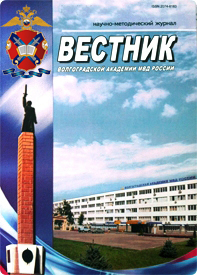The issue of the legal rule’s structure is important because it allows to work out a proper understanding of the nature and features of the given rule perceived as a significant element of law within any kind of law interpretation. The idea of the three-element structure of the legal rule has been developed by the Russian legal science. The four-element structure of the rule is similar to the previous one. There are no examples of either three-element or four-element structure of legal rules in the legislation, so Russia’s legal science has formulated the notion of the logical rule of law. But the logical legal rule is not the real legal rule. This is a construction of metalanguage, an element of scientific language. And the given scientific construction doesn’t reveal any logical connections. The implication is expressed through the construction «if - then». However the legal rule is not implication because it doesn’t have the meanings «true» or «false» in accordance with the classical concept of «verity». The construction «if - then - else» is similar to the command of conditional jump. But the command of conditional jump is in itself a specific combination of two commands and consequently differs radically from the logical legal rule. Thus the legal rule is dyadic, i.e. it has a two-element structure. Its elements are only a hypothesis and a disposition which are always present in the legal rule. The given elements don’t change their character. It’s not correct to consider a disposition and a sanction as such elements. The protective legal rule is not logically deduced from the regulatory legal rule. Enforcement of the legal rule through sanctions is provided by a specific combination of two legal rules.
legal rule, structure of the legal rule, structural element of the legal rule, hypothesis of the legal rule, disposition of the legal rule, sanction of the legal rule, state enforcement
1. Cherdancev A. F. Logiko-yazykovye fenomeny v yurisprudencii. M., 2012.
2. Golunskiy S. A. K voprosu o ponyatii pravovoy normy // Sov. gos-vo i pravo. 1961. № 4.
3. Alekseev S. S. Obschaya teoriya prava. M., 1982. T. 2.
4. Leushin V. I. Logicheskaya norma i normativnoe predpisanie (strukturnyy analiz) // Ros. ezhegodnik teorii prava. 2009. № 2. S. 605-611.
5. Yavich L. S. Pravo i obschestvennye otnosheniya. Osnovnye aspekty soderzhaniya i formy sovetskogo prava. M., 1971.
6. Informatika i matematika dlya yuristov: uchebnik dlya studentov vuzov, obuchayuschihsya po yurid. special'nostyam / pod red. S. Ya. Kazanceva, N. M. Dubininoy. 2-e izd., pererab. i dop. M., 2008.
7. Korkunov N. M. Lekcii po obschey teorii prava. M., 2010.
8. Mihaylovskiy I. V. Ocherki filosofii prava. Tomsk, 1914.
9. Taranovskiy F. V. Uchebnik enciklopedii prava. Yur'ev, 1917.
10. Obschaya teoriya sovetskogo prava / pod red. S. N. Bratusya, I. S. Samoschenko. M., 1966.
11. Lectures on Jurisprudence. Being the sequel to «The Province of Jurisprudence Determined» to which are added notes and fragments». Now first published from the Original Manuscripts. By the late John Austin. New York, 1970. Lecture XLV.
12. Leyst O. E. Sankcii v sovetskom prave. M., 1962.









